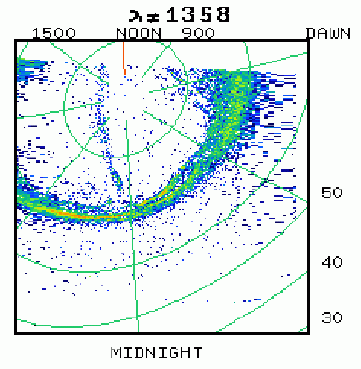 Sun-aligned arcs
Sun-aligned arcs
spaceweb@oulu.fi - last update: 21 December 1998, 1440 UT (RR)

Introduction
Sun-aligned arcs
are auroral features found
within the polar cap, as opposed to the
auroral oval where the more typical
arcs reside. First global image of this phenomenon
was reported by Frank et al. (1982); it consists of luminous belt
reaching across the polar cap from noon to midnigh (that is why it is
also called theta aurora; terms transpolar or polar cap arc are also known).
However, first visual observations of such features were by the
British Antarctic Expedition already during the austral winter of 1908
(Mawson, 1916). Similarly, first ground-based all-sky-camera
observations originate from the International Geophysical Year (IGY)
of 1957-1958 (Davis, 1962; Feldstein, 1963).
Characteristics
The arc is about a hundred kilometers wide or more, and its luminosity
may be comparable to the average emissions within the oval (typically,
however, it is less than that). The feature can last for several hours,
and it moves slowly across the polar cap in the direction of the
IMF By component in the northern
hemisphere (Frank et al., 1986). This motion is in the opposite
direction in the southern hemisphere for the same sign of By (Craven
et al., 1991).
Although the sun-aligned arcs are of much larger scale (and weaker)
than the typical arcs found in the auroral oval, the word 'arc' is
appropriate in one sense: at least sometimes they show signatures of
inverted-V type electron spectra, indicating similar
field-aligned acceleration
than seen in other discrete aurora
(Frank et al., 1986).
It has been argued that the arc is most likely located on closed
field lines, and connected to distant
plasma sheet or its
boundary layer (PSBL; see, e.g., Menietti and Burch, 1987).
Note that if polar cap is defined as a region of open field lines,
sun-aligned arcs are not anymore 'polar cap' events!
IMF relation
The formation of a sun-aligned arc requires a prolonged
period of non-positive IMF Bz, and a subsequent change in either
Bz or By component (Newell and Meng, 1995; Chang et al., 1998).
They are most likely caused by changes in the
merging rates in the dayside
magnetopause affecting
the global plasma convection.
See Rodriguez et al. (1997) for discussion of arc decay after
southward turning of IMF, delay being 15-30 minutes.
References
- Chang, S.-W., J. D. Scudder, J. B. Sigwarth, L. A. Frank,
N. C. Maynard, W. J. Burke, W. K. Peterson, E. G. Shelley, R. Friedel,
J. B. Blake, R. A. Greenwald, R. P. Lepping, G. J. Sofko, J.-P. Villain,
and M. Lester, A comparison of a model for the theta aurora with
observations from Polar, Wind, and SuperDARN, J. Geophys. Res., 103,
17367-17390, 1998.
- Craven, J. D., J. S. Murphree, L. A. Frank, and L. L. Cogger,
Simultaneous optical observations of transpolar arcs in the two
polar caps, Geophys. Res. Lett., 18, 2297, 1991.
- Davis, T. N., The morphology of the auroral displays of 1957-1958, 2,
Detail analyses of Alaska data and analyses of high-latitude data,
J. Geophys. Res., 67, 75-110, 1962.
- Feldstein, Y. I., Some problems concerning the morphology of auroras
and magnetic disturbances at high latitudes, Geomagn. Aeron.,
Engl. Transl., 3, 183-192, 1963.
- Frank, L. A., J. D. Craven, J. L. Burch, and J. D. Winningham,
Polar views of the Earth's aurora with Dynamics Explorer, Geophys.
Res. Lett., 9, 1101, 1982.
- Frank, L. A., J. D. Craven, D. A. Gurnett, S. D. Shawhan, D. R. Weimer,
J. L. Burch, J. D. Winningham, C. R. Chappell, J. H. Waite, R. A. Heelis,
N. C. Maynard, M. Sugiura, W. K. Peterson, and E. G. Shelley,
The theta aurora, J. Geophys. Res., 91, 3177-3224, 1986.
- Mawson, D., Auroral observations at the Cape Royds station, Antarctica,
Trans. R. Soc. S. Aust., 40, 151-212, 1916.
- Menietti, J. D. and J. L. Burch, DE 1 observations of theta aurora
plasma source regions and Birkeland current charge carriers,
J. Geophys. Res., 92, 7503-7518, 1987.
- Newell, P. T., and C.-I. Meng, Creation of theta-auroras: The
isolation of plasma sheet fragments in the polar cap, Science, 270,
1338, 1995.
- Rodriguez, J. V., C. E. Valladares, K. Fukui, and H. A. Gallagher Jr.,
Antisunward decay of polar cap arcs, J. Geophys. Res., 102,
27227-27247, 1997.
- Shiokawa, K., T. Ogino, K. Hayashi, D. J. McEwen, Quasi-periodic
poleward motions of morningside sun-aligned arcs: A multi-event study,
J. Geophys. Res., 102, 24325-24332, 1997.
See also:
 Sun-aligned arcs
Sun-aligned arcs Sun-aligned arcs
Sun-aligned arcs